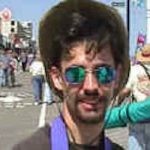Going Beyond Dimension
Last month I wrote about using the camera to convey space in a two-dimensional field. After this article, an observant reader wrote in the following letter to me:
Hi Could you tell me how to make those stereo graphic [two photos of same object but made at a slightly different angle] without using a special camera. There are books that show photos that do not need the stereographic viewer to see things in depth.
Well, the truest answer to this question, to my knowledge is: Yes And No…so, I thought I’d take a short break from composition to tell you about this interesting photo technique.
First, The Yes Part…
The first answer to the question “Can I take pictures in 3-D without a special viewer?” is “Yes, BUT…”
The “BUT” part comes in when you actually take the picture. For a non-special-viewer-true-3D picture, you must use a special CAMERA. These cameras usually have between 2-4 lenses, all set at a different focal length, which record the image on three separate frames of your film. For this example, we will assume that our camera has 3 lenses, near, mid, and far. The images on these frames are all slightly closer or further than the others, resulting in 3 different sized pictures. When you take this film to the processor, they usually send it out to a special lab. The lab takes the prints of all the frames that correspond to each other and send them through a computer that divides the 3 pictures into tiny strips. It then mixes them using an algorithm. The resulting print looks like a badly assembled puzzle, with the sizes in ascending order, near-mid-far-near-mid-far, etc. A special plastic coating is then applied to the surface of the picture, which displays only one set of strips at a time. When our eyes look at the picture, our minds apply rules to sort out the mess and we get a pseudo-feeling of depth.
It sounds complicated, and in truth it is. The cameras (at least ones of good quality) are expensive, and so is the processing. The results are OK, and if done right, can really turn out nice.
…Now The “No” Part…
There are some flaws with this process, however, and this is where the “No” part comes in. The problem with the process above, besides it’s cost, are that the results are not a true 3-D effect, and sometimes you have to wiggle the print a bit to see it in that pseudo-3-D, It’s like those animated prints you would get, that if you looked at it one way, you saw one half of the animation, if you looked at it the other way, you saw a movement. So, there is the closer to 3-D way, which is to use two regular cameras (SLR’s recommended) mounted on a T-bracket. Using zoom lenses set at slightly different focal lengths, you can actually take two different views of the same shot, much like your eyes do. After getting them processed, you will need to mount these photos on a card and find a stereoscopic viewer (remember those ViewMaster toys you had as a kid?). This will render a more true to life 3 dimensional view. It is a process, though, that requires LOTS and LOTS of experimentation to perfect, and even then, you have to be very careful about your shots. I would recommend using slides for this, as they tend to be easier to mount.
…And Now, The Inevitable “Maybe”
Then there are the “Magic Eye Stereograms,” which require no special viewer, but a special eye technique that has no real description. It’s sort of like crossing your eyes and focusing beyond the picture plane. Unfortunately, these are not photographs at all, but really computer generated 3-D models with a disturbance field laid over them. I won’t pretend to know the exact science behind how they work, but it has something to do with subliminal changes in the disturbance field that correspond to the shapes, so it is not really photography.
So What Does It All Mean, For Kites?
To make this all work successfully, composition-wise (yes, I know I said I would take a break, but I guess you can’t escape it), you need to do one thing: define a near, mid, and far field of subjects. In essence, you need to have a strong subject in all three planes of view, or else you won’t see any separation at all. So, if you want to give this a go, I’ll supply you some great 3-D kickstart ideas:
- Spectators, flyer, kite
- The inevitable Ripstop Jungle that appears at the sidelines of most events
- Perspective shots of Stunt Tricks
- Candids of flyers with their kites
- Indoor Events
 These are just a few. In fact, any picture with a definitely strong sense of depth should work well, as long as it has three distinct layers of subject: near, middle, and far.
These are just a few. In fact, any picture with a definitely strong sense of depth should work well, as long as it has three distinct layers of subject: near, middle, and far.
And as always, specific questions can be e-mailed to me, I don’t mind. If you find any other information contrary to this article (you know how technology is) PLEASE mail me. Until next time, shoot more and fly more.
MW

